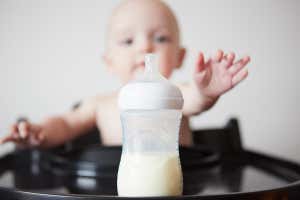
Emma Kim/Getty Images
Plastic feeding bottles release an average of 4 million microplastic particles per litre into baby formula during preparation, but it still isn’t clear whether ingesting microplastics is harmful to infant health.
John Boland at Trinity College Dublin in Ireland and his colleagues measured microplastics released during the process of baby formula preparation in feeding bottles made of polypropylene plastic, which they estimate account for almost 69 per cent of such bottles available on the market.
The researchers cleaned and sterilised brand-new polypropylene feeding bottles, left them to dry and then poured in purified water, which had been heated to 70°C, the World Health Organization-recommended temperature for infant formula preparation.
Advertisement
After putting the bottles on a mechanical shaker for a minute to mimic the formula mixing process, Boland and his team filtered the water and analysed it under a microscope. They discovered that the bottles were leaking an average of 4 million microplastic particles per litre into the water inside, with a range of between 1 and 16 million particles per litre. The researchers found similar results when they used water containing baby formula.
“We were surprised by the quantity,” says Boland. “Based on research that has been done previously looking at the degradation of plastics in the environment, we had a suspicion that the quantities would be substantial, but I don’t think anyone expected the very high levels that we found.”
Boland says his team was also surprised to discover that the shedding of microplastics by the bottles was temperature dependent. When the researchers repeated their experiments using water at a range of temperatures, they found that particle shedding accelerated as temperature rose. Shaking the bottles also increased microplastic release.
The results are in line with previous research, including a study revealing that plastic tea bags shed billions of microplastic particles into each cup. But it still isn’t clear whether ingesting microplastics has any impact on human health. “We don’t know yet if there are any adverse health effects from exposure to microplastics,” says Boland.
“The sources of plastic particles involved in human exposure are important to identify,” says Heather Leslie at VU Amsterdam in the Netherlands. “There is currently no norm for maximum tolerable daily intake for plastic particles.”
It is recommended that feeding bottles are sterilised and baby formula heated to destroy potentially harmful bacteria. Any potential risks that may be posed to infants by microplastics should therefore be weighed against the risks of exposure to harmful bacteria, says Ingeborg Kooter at the Netherlands Organisation for Applied Scientific Research (TNO). “How does this risk compare to the risk of salmonella infection?”
If people are concerned, they can reduce the level of microplastics generated during formula preparation by minimising the plastic bottle’s exposure to heat and shaking, says Boland. For instance, the formula could be prepared in a separate, non-plastic container and only transferred over to a sterilised plastic feeding bottle once the formula has cooled, he suggests.
Journal reference: Nature Food, DOI: 10.1038/s43016-020-00171-y
More on these topics:
